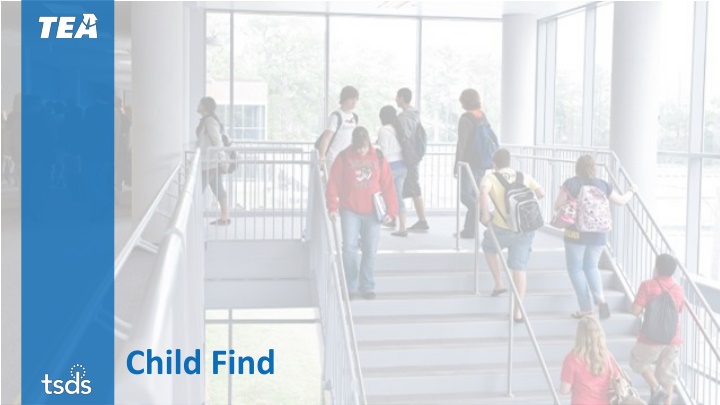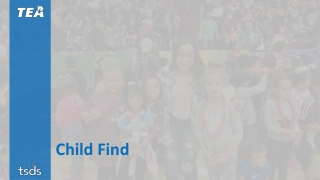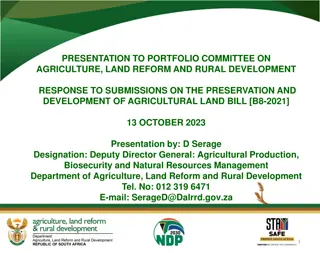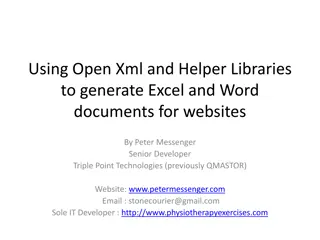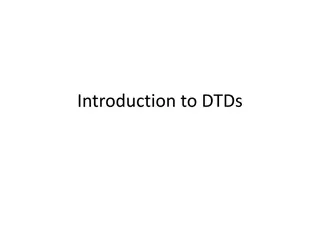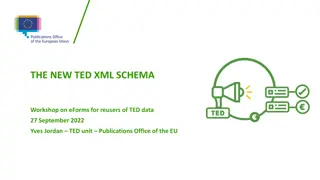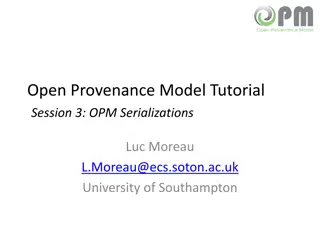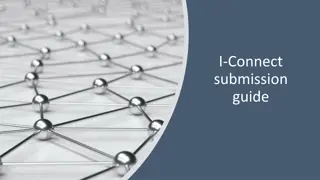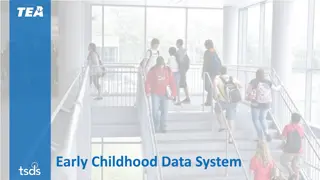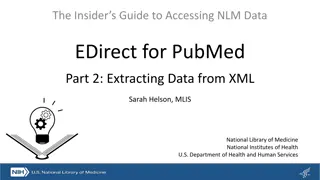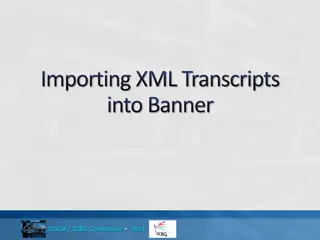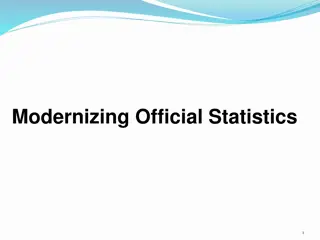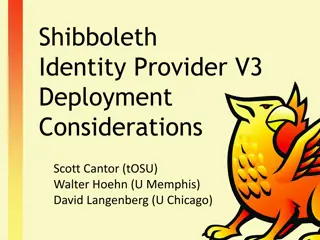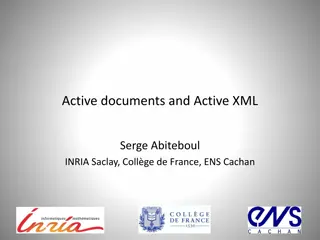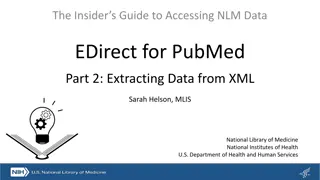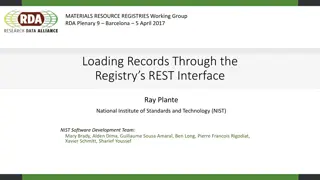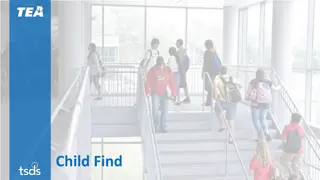Changes in Official XML Data Submissions for the 2022-2023 School Year
The focus of this presentation is on the changes in official XML data submissions for the upcoming 2022-2023 school year, particularly in the context of the Child Find program. It covers a range of updates, guidance, submission timelines, data elements, and known issues related to the collection of data. Additionally, it provides an overview of the Child Find program's objectives and the indicators used for reporting. The information presented sheds light on the process involving students evaluated for special education services and the significance of timely evaluations. Notable details include the submission deadlines, application readiness, and the overall structure of data collection. Furthermore, it explores the criteria for including students in the evaluation process and addresses scenarios involving non-enrolled students receiving services outside traditional educational settings.
Uploaded on Sep 24, 2024 | 1 Views
Download Presentation

Please find below an Image/Link to download the presentation.
The content on the website is provided AS IS for your information and personal use only. It may not be sold, licensed, or shared on other websites without obtaining consent from the author.If you encounter any issues during the download, it is possible that the publisher has removed the file from their server.
You are allowed to download the files provided on this website for personal or commercial use, subject to the condition that they are used lawfully. All files are the property of their respective owners.
The content on the website is provided AS IS for your information and personal use only. It may not be sold, licensed, or shared on other websites without obtaining consent from the author.
E N D
Presentation Transcript
PLEASE NOTE: The focus of this presentation is on the changes for the official XML data submissions during the 2022-2023 school year.
AGENDA Child Find Program Area Updates & Guidance 2021-2022 Submission Updates Overview of the Data Collection Current Known Issues 2022-2023 Changes Application Updates Data Element Updates Report Updates Business Rule Updates Code Table Updates Timeline Frequently Asked Questions Technical Resources Questions
PROGRAM AREA UPDATES & GUIDANCE Division of Special Education Program Reporting Zane Wubbenna Data Analyst; Department of Monitoring, Reporting, and Support Tammy Pearcy Director; Department of Monitoring, Reporting, and Support
2021-2022: SUBMISSION UPDATES The 2021-2022 Child Find data collection is due on July 28, 2022. The application will be ready for users to complete on June 6, 2022.
Overview of the Data Collection Child Find combines the following two State Performance Plan (SPP) Indicators in TSDS: SPPI-11 o Refers to the timely evaluation of students, ages 3-21, for special education services under Part B of IDEA. SPPI-12 o Refers to children who are referred from Part C of IDEA prior to age 3, found eligible for Part B of IDEA, and have an individualized education plan (IEP) developed and implemented by their third birthday to receive early childhood special education (ECSE) services from a local education agency (LEA).
Overview of the Data Collection The data collection includes students for whom the special education evaluation process was completed. In some cases, this may include non-enrolled students such as homeschooled students, private school students, or children who received Early Childhood Intervention services through another state agency. For the 2021-2022 submission, the completed evaluation/eligibility process is based on an eligibility determination date on or between July 1, 2021 June 30, 2022. This includes holdover students , whose parental consent was obtained in the 2020-2021 school year and the evaluation/eligibility process was completed in the current school year.
Overview of the Data Collection All students reported in TSDS must be reported with a Unique ID, including non-enrolled students. LEAs should make every effort to find a non-enrolled student s existing Unique ID, just as they do for enrolled students, in the event one was previously created by another LEA. Search the Unique ID application for the student. Rely on any information provided by the parents or previous LEAs. Students who already have a Unique ID should not be assigned a new one. LEAs should fill in all fields to the best of their ability for any new Unique ID that must be created for a non-enrolled student. The LEA may use S-numbers in place of SSNs and utilize alternative field options (such as TEA Use Only for Ethnicity/Race), where applicable. Additionally, LEAs can utilize NA for Grade Level or estimate the child s approximate grade based on their age.
Overview of the Data Collection Child Find promotes data from the following TSDS interchanges: InterchangeEducationOrganizationExtension InterchangeEducationOrgCalendar InterchangeStudentParentExtension InterchangeStudentEnrollmentExtension InterchangeStudentProgramExtension
Overview of the Data Collection Student Program data elements reported for both SPPI-11 and SPPI-12 students: E1710 CAMPUS-ID-OF-EVALUATION E0975 INSTRUCTIONAL-TRACK-INDICATOR-CODE E1711 STUDENT-ABSENCES-WITHIN-TIMEFRAME E1714 PARENTAL-CONSENT-DATE o Report the first instructional day following the date on which the LEA received written consent for the full individual and initial evaluation (FIIE) from the student s parent. E1715 INITIAL-EVALUATION-DATE E1716 SPED-ELIGIBILITY-DETERMINATION-DATE E1717 SPED-ELIGIBILITY-DETERMINATION-CODE E1718 EVALUATION-DELAY-REASON
Overview of the Data Collection Additional Student Program data elements reported only for SPPI-12 students: E1632 EFFECTIVE-DATE (TX-EffectiveDateServices) E0900 EARLY-CHILDHOOD-INTERV-IND-CODE E1712 ECI-NOTIFICATION-DATE E1713 ECI-TRANSITION-CONFERENCE-DATE
Overview of the Data Collection For students where E1714 PARENTAL-CONSENT-DATE is in the prior school year holdover students Child Find also uses the following calendar data from the prior year s PEIMS Summer Accepted data: CalendarDateExtension ReportingPeriodExtension The Core application will retrieve this certified data automatically. LEAs do not need to reload any of this PEIMS data for the Child Find data collection.
Overview of the Data Collection The Core application also performs calculations based on the data elements being reported. The calculated data includes: The Initial Evaluation and SPED Eligibility Determination compliance for each student. The overall SPPI-11 and SPPI-12 compliance for each student, based on which indicator applies to them. The number of days beyond timeframe to complete the initial evaluation/eligibility determination process for non- compliance students. These calculations display on reports and appear in data validation rules.
Overview of the Data Collection Students for whom non-compliance is calculated must have an evaluation delay reason reported from the DC164 code table. A student that is reported with either of the following delay reasons will be considered in compliance . 05 Parent Delay (Detailed Records Maintained by LEA Regarding a Parent of a Child who Repeatedly Fails or Refuses to Produce the Child for the Evaluation) 07 LEA Agreement with Parent to Timeframe (Detailed Records Maintained by LEA)
Overview of the Data Collection The following subcategories of data are used in Child Find: Education Organization o Local Education Agency o Campus o Calendar Student o Student Basic Information o Enrollment (School Association) o Special Education Program Due to the interdependency and complexity of the calculations being performed, users are only able to promote data by ALL CATEGORIES.
Overview of the Data Collection The following criteria logic will be applied when promoting students to the Child Find data mart: 21 years of age or younger on September 1, 2021. Reported with a value for data element E1716 SPED-ELIGIBILITY- DETERMINATION-DATE between July 1, 2021 June 30, 2022.
Overview of the Data Collection There are four reports at the LEA and ESC levels; two each for SPPI-11 and SPPI-12. CHF0-000-001: TSDS SPPI-11 Student Compliance Report CHF0-000-002: TSDS SPPI-12 Student Compliance Report CHF0-000-003: TSDS SPPI-11 Aggregate Report CHF0-000-004: TSDS SPPI-12 Aggregate Report
CURRENT KNOWN ISSUES The spacing on some of the column headers is not aligned properly on the two Child Find reports listed below. This is a cosmetic issue and does not affect the contents of the report. CHF0-000-001: TSDS SPPI-11 Student Compliance Report CHF0-000-002: TSDS SPPI-12 Student Compliance Report This issue will be re-evaluated in the 2022-2023 school year.
2022-2023: APPLICATION UPDATES The Child Find data collection will be updated to collect the following new element: ELIGIBILITY-DELAY-REASON (E1731) This optional data element will be collected in the TX- DelayReason sub-complex type in the InterchangeStudentProgramExtension.
2022-2023: DATA ELEMENT UPDATES Element ID E1718 Data Element Date Issued 03/01/2021 Date Updated 12/01/2021 EVALUATION-DELAY-REASON XML Name TX-EvaluationDelayReason Definition EVALUATION-DELAY-REASON refers to the reason justification as to why the written full individual and initial evaluation (FIIE) report was completed beyond the required timeframe. For SPPI-11, the required evaluation timeframe is 45 instructional days unless one or both of the following exceptions are triggered, including the number of instructional days left in the year after parental consent and/or the number of student absences that occurred during the State-established 45 instructional day timeframe. For SPPI-12, the required evaluation timeframe is by the third birthday for a child receiving early childhood intervention (ECI) services. State-established 45 instructional day timeframe for state performance plan indicator 11 (SPPI-11), or the reason justification as to why a child who was receiveding early childhood intervention (ECI) services had their eligibility FIIE for early childhood special education (ECSE) services completed after the child s third birthday for state performance plan indicator 12 (SPPI-12). Special Instructions This data element pertains to both state performance plan indicator 11 (SPPI-11) for students ages 3-21 being considered for special education supports and services and SPPI-12 for students who received early childhood intervention (ECI) services and were considered potentially eligible for early childhood special education (ECSE) when they three years old. Regarding SPPI-11, exceptions to the State-established 45 instructional day FIIE timeframe are conditioned on the number of instructional days left in the year after parental consent and the number of student absences. See TEC 29.004(1), (a-1), and (a-2) See 19 TAC 89.1011(c), (e), (g), and (h) Regarding SPPI-12, exceptions existed pertaining to the number of calendar days prior to the child s third birthday that they started receiving ECI services. See 34 CFR 303.209 See 40 TAC, 108.1215 See TEA/DARS Early Transition Memorandum of Understanding (ECI MOU) https://tea.texas.gov/sites/default/files/TEA%20%20HHSC%20ECI%20-%20MOU.pdf
2022-2023: REPORT UPDATES The following reports will be updated to add a column for the new element ELIGIBILITY-DELAY-REASON (E1731). CHF0-000-001: TSDS SPPI-11 Student Compliance Report CHF0-000-002: TSDS SPPI-12 Student Compliance Report More information, including updated report mockups, will be shared prior to the start of the 2022-2023 school year.
2022-2023: BUSINESS RULE UPDATES Updated Business Rules
2022-2023: BUSINESS RULE UPDATES New Business Rules
2022-2023: CODE TABLE UPDATES Renamed EVALUATION-DELAY-REASON-CODE (DC164) to DELAY-REASON-CODE (DC164) There are several code definitions that refer to detailed records. Added additional information in the code table related to Detailed Records . o Detailed Records may include, but are not limited to, certified letters, detailed physician s letters, comprehensive records of phone calls made or attempted along with the results of those calls, copies of correspondence sent to parents and any responses received, records of visits made to the parent s home or place of employment and the results of those visits, a log of multiple attempts to contact parents or guardians. o Detailed records should be collected and maintained for each student as evidentiary support for the selected delay reason. The records maintained by the LEA are subject to inspection for auditing and data validation purposes by the Department of Review and Support at the Texas Education Agency (TEA).
2022-2023 TIMELINE Child Find Collection Date TSDS ready to load data to eDM August 1, 2022 Child Find ready for users to promote data September 12, 2022 Child Find ready for users to complete May 15, 2023 Child Find submission due date for LEAs July 27, 2023
FREQUENTLY ASKED QUESTIONS Which students are reported for Child Find? Only students for whom the special education evaluation/eligibility process has been completed shall be reported. This is indicated by data element E1716 SPED-ELIGIBILITY-DETERMINATION-DATE with a date between July 1, 20XX June 30, 20XY in the current school year. For the 2021-2022 submission, this date must fall between July 1, 2021 June 30, 2022.
FREQUENTLY ASKED QUESTIONS Should the actual day the parent provides consent for evaluation be reported for E1714 PARENTAL-CONSENT-DATE? No. The data element E1714 PARENTAL-CONSENT-DATE represents the first instructional day following the day the LEA receives written consent for the full individual and initial evaluation (FIIE) from the student s parent.
FREQUENTLY ASKED QUESTIONS How should E1718 EVALUATION-DELAY-REASON be reported for students whose eligibility determination is delayed but not their evaluation? Why is there no data element to track the eligibility delay? For SPPI-11 students, LEAs shall only report delays related to the initial evaluation using element E1718 EVALUATION-DELAY-REASON. If the student does not have an evaluation delay but does have an eligibility delay, no delay reason shall be reported. For SPPI-12 students, the LEA shall use E1718 to report the delay for either the evaluation or the eligibility determination, whichever one was delayed, as both must be completed prior to the child s 3rdbirthday. In the 2022-2023 school year and going forward, Child Find will collect a new data element, ELIGIBILITY-DELAY-REASON, to track delays related to the eligibility determination for both SPPI-11 and SPPI-12 students.
FREQUENTLY ASKED QUESTIONS How should the data be reported for non-enrolled students? In general, both enrolled and non-enrolled students will bereported the same in Child Find. However, the StudentSchoolAssociation data in the InterchangeStudentEnrollmentExtension will not be reported for non- enrolled students. Additionally, optional data elements such as INSTRUCTIONAL-TRACK-INDICATOR-CODE and STUDENT-ABSENCES- WITHIN-TIMEFRAME may not apply to non-enrolled students and are not required to be reported. LEAs must obtain and report a Unique ID for all non-enrolled students reported in Child Find.
FREQUENTLY ASKED QUESTIONS How does the data collection account for school closures related to Covid-19 or bad weather days? Are those days included in the 45-day initial evaluation timeline? Child Find uses the calendar data that is reported in the LEA s InterchangeEducationOrgCalendar to determine which days are instructional vs non-instructional. Any SCHOOL-DAY-EVENT-CODE marked with code 01 Student Instructional Day (whole or partial day) is counted toward the 45-day initial evaluation timeline.
TECHNICAL RESOURCES Technical Support: TSDSCustomerSupport@tea.texas.gov Child Find Program Area spp@tea.texas.gov TAA Letters Child Find (SPPI-11 & SPPI-12) in the Texas Student Data System o Published July 8, 2021 TSDS Child Find Eligibility Delay Reason (TBD) TIMS Knowledge Base Articles TSDSKB-620: SPPI-11 Compliance Flow Chart TSDSKB-621: SPPI-12 Compliance Flow Chart TSDSKB-622: Child Find Frequently Asked Questions
